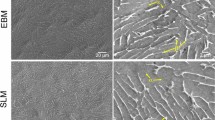Abstract
Room temperature tensile properties of Ti-47.5Al-1V-0.2C (at%) and Ti-48.2Al-1V-.06C (at%) alloys were measured after thermal exposure at 775°C (in air and vacuum) to evaluate the influence of carbide precipitation and environment. Both alloys possess ≈2% tensile ductility in the unexposed condition. Thermal exposure of fully machined tensile samples consistently reduces the ductility of the 0.2 carbon alloy to ≈0.5%. Exposure of the low carbon (0.06) alloy in vacuum results in no ductility loss, while exposure in air reduces the ductility to 1.3%. Yield strengths are unaffected by thermal exposure and are 450 MPa and 300 MPa for the 0.2 and the low carbon alloys, respectively. The pre-exposure ductility is recovered for tests in which thermally exposed machined tensile samples had ≈10μm of their surfaces removed by polishing. Thermal exposure prior to machining results in no change in tensile behavior. SEM and TEM examination of thermally exposed surfaces show that below the oxide surface layer, a layer close in composition to Ti2Al, having a simple cubic (ao=6.85Å) structure is present. Beneath this layer, Ti3AlC carbides are observed in the 0.2 carbon alloy. The density of these carbides is observed to decrease away from the surface. No carbides were observed in the low carbon alloy. Although carbon significantly enhances the yield strength of this alloy it also makes it much more susceptible to embrittlement from thermal exposure.
Similar content being viewed by others
References
Y.-W. Kim, Journal of Metals, 41, 24, (1989)
D.S. Shih, S.C. Huang, G.K. Scarr, H. Jang and J.C. Chestnutt, in Microstructure/Property Relationships in Titanium Aluminides & Alloys, edited by W-Y Kim and R.R. Boyer, TMS, 135 (1991).
S. Chen, P.A. Beaven and R. Wagner, Scripta Metall., 26, 1205, (1992).
W.T. Donlon, and W.E. Dowling (unpublished results).
K.C. Antony, Journal of Materials, 1, 456, (1966).
G.H. Meier and F.S. Pettit, Mats. Sci. and Eng., A153, 548, (1992).
W.E. Dowling, Jr. and J.E. Allison, in Proc. 4th Int. Conf. on Fatigue and Fatigue Thresholds, Part III, edited by H. Kitagawa and T. Tanaka, 1923, (1990).
W.E. Dowling, Jr. and W.T. Donlon, Scripta Metall., 27, 1663, (1992).
K. Maki, M. Shioda, M. Sayashi, T. Shimizu and S. Isobe, Mats. Sci. and Eng., A153, 591, (1992).
Acknowledgments
The authors thank J.E. Allison, W.B. Copple and F.A. Alberts for their contributions to this paper.
Author information
Authors and Affiliations
Rights and permissions
About this article
Cite this article
Donlon, W.T., Dowling, W.E. The Effect of Carbon and Thermal Exposure on the Tensile Behavior of Ti-48Al-1V (at%). MRS Online Proceedings Library 288, 629–634 (1992). https://doi.org/10.1557/PROC-288-629
Published:
Issue Date:
DOI: https://doi.org/10.1557/PROC-288-629




